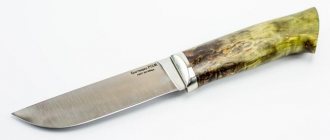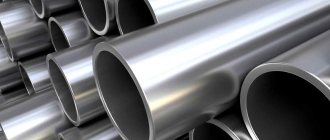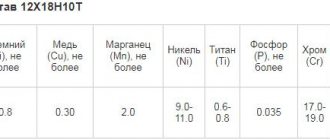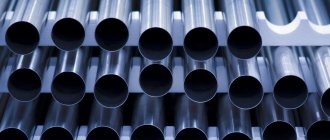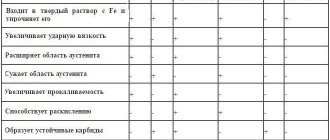Stainless steel structural steel 12Х18Н10Т is an alloy that can be used in a wide variety of conditions and environments. Steel 12Х18Н10Т is not subject to corrosion and behaves well under aggressive conditions in solutions of acetic and phosphoric acids, dilute alkalis, and salts. Steel 12Х18Н10Т retains its characteristics over a wide temperature range. This alloy is completely environmentally friendly, safe for health, and is therefore successfully used in the food industry. Steel 12Х18Н10Т is excellent at welding in various ways and is easy to machine, which allows the use of stainless steel in the manufacture of metal structures of any type. On our website you can place an order, view delivery information, and ask questions.
Interpretation of steel 12Х18Н10Т
Steel grade 12Х18Н10Т indicates the chemical composition of the alloy, where the letters are chemical elements, and the numbers are their percentage content in the composition.
- The number 12 indicates a carbon content of no more than 0.12%. Carbon content affects the structure and determines the strength and hardness of steel. High-carbon steel is the strongest, but suffers from a lack of ductility, toughness and sensitivity to heat treatment.
- X18 is an indicator of chromium content, which contains no more than 18%. Chromium is a common alloying additive that protects steel from corrosion and oxidation, increases strength without losing the ductility of the alloy.
- H10 indicates a nickel content of no more than 10%. Nickel is an alloying additive that promotes the formation of austenite. Together with chromium, nickel significantly increases the thermal hardening and toughness of steel.
- The letter T indicates a titanium content of approximately 1%. Titanium, like the two previous elements, promotes corrosion resistance, strengthens the metal, increases ductility and affects hardenability depending on the proportion of content (it can either increase or decrease).
The composition contains in small quantities the following elements: silicon (Si), manganese (Mn), sulfur (S), phosphorus (P), molybdenum (Mo), vanadium (V), copper (Cu), tungsten (W), aluminum (Al). The basis of the alloy is iron (Fe).
Chemical composition, % (GOST 5632-2014)
| Steel | C | Si | Mn | Cr | Ni | Ti | S | P |
| 12Х18Н10Т | no more than 0.12 | no more than 0.80 | no more than 2.00 | 17,0-19,0 | 9,0-11,0 | 5,0-8,0 | no more than 0.02 | no more than 0.40 |
Characteristics
Steel 12Х18Н10Т belongs to high-carbon complex alloyed stainless cryogenic alloys. The main alloying components are chromium and nickel; they prevent rusting, provide the metal with cryogenic properties (resistance to cooling) and high manufacturability. Steel 12Х18Н10Т is used in the temperature range from -196С to +600С. The specific gravity of the 12Х18Н10Т alloy is 7.9 g/cm3. The price of stainless steel sheet 12Х18Н10Т starts from 250 rubles per kilogram. You will find detailed information on our company website.
Weldability of the grade
In order to be able to weld 12x18n10t steel with high quality without difficulty, it is important to pay attention to the composition of the electrodes selected for the work. If you want to obtain a weld metal that is resistant to intercrystalline corrosion, you should choose electrodes with a high content of alloying components. When these components are mixed with 12x18n10t steel, improved seams will be obtained that will have even better properties than the base metal.
With the help of properly selected electrodes, you can significantly change the performance characteristics of the deposited weld.
In simple terms, the weldability of the metal is quite good; no additional firing or subsequent processing is required. However, there is one feature that is definitely worth paying attention to.
You need to very carefully monitor the percentage of metals in steel, otherwise you may end up with a material that is completely different from what you originally expected. Be sure to seek help from professionals so as not to get into trouble.
Physical properties
Density ρ at test temperature, 20 °C 7900 kg/cm3
Thermal conductivity coefficient λ W/(m*K) at test temperature, °C
| Steel | 20 | 100 | 200 | 300 | 400 | 500 | 600 | 700 | 800 | 900 |
| 12Х18Н10Т | 15 | 16 | 18 | 19 | 21 | 23 | 25 | 27 | 26 |
Electrical resistivity ρ, nOhm*m, at test temperature °C
| Steel | 20 | 100 | 200 | 300 | 400 | 500 | 600 | 700 | 800 | 900 |
| 12Х18Н10Т | 725 | 792 | 861 | 920 | 976 | 1028 | 1075 | 1115 |
Specific heat capacityc, J/(kg*K), at test temperature, °C
| 20-100 | 20-200 | 20-300 | 20-400 | 20-500 | 20-600 | 20-700 | 20-800 | 20-900 | 20-1000 |
| 462 | 496 | 517 | 538 | 550 | 563 | 575 | 596 |
Thermal conductivity coefficient λ, W/(m*K), at test temperature, °C
| 20 | 100 | 200 | 300 | 400 | 500 | 600 | 700 | 800 | 900 |
| 15 | 16 | 18 | 19 | 21 | 23 | 25 | 27 | 26 |
Linear expansion coefficient α*106, K-1, at test temperature, °C
| 20-100 | 20-200 | 20-300 | 20-400 | 20-500 | 20-600 | 20-700 | 20-800 | 20-900 | 20-1000 |
| 16,6 | 17,0 | 17,2 | 17,5 | 17,9 | 18,2 | 18,6 | 18,9 | 19,3 |
Modulus of normal elasticity E, GPa, at test temperature °C
| Steel | 20 | 100 | 200 | 300 | 400 | 500 | 600 | 700 | 800 | 900 |
| 12Х18Н10Т | 198 | 194 | 189 | 181 | 174 | 166 | 157 | 147 |
Modulus of elasticity in torsional shear G, GPa, at test temperature °C
| Steel | 20 | 100 | 200 | 300 | 400 | 500 | 600 | 700 | 800 | 900 |
| 12Х18Н10Т | 77 | 74 | 71 | 67 | 63 | 59 | 57 | 54 | 49 |
Advantages and disadvantages
The main advantages of steel 12Х18Н10Т are:
- resistance to rusting when in contact with water;
- maintaining performance characteristics over a wide temperature range;
- resistance to aggressive influences of a large number of acids, alkalis, salts;
- environmental friendliness and health safety;
- high levels of strength, hardness, impact strength, ductility;
- good weldability;
- lack of flake sensitivity.
Steel 12Х18Н10Т is sensitive to corrosion when in contact with substances containing chlorine, as well as sulfuric and hydrochloric acids. This is considered the main disadvantage of the alloy.
Weldability
Steel 12Х18Н10Т has no restrictions on weldability. The following methods are used for welding:
- manual and automatic arc welding;
- electroslag;
- contact
Subsequent heat treatment is not necessary, but is recommended to prevent susceptibility to knife corrosion.
Type of delivery
The main type of supply of steel grade 12Х18Н10Т is stainless steel sheet. Sheet steel of this class is the most popular on the market, in demand in all industries, and always sells well. Flat metal can be hot-rolled or cold-rolled; some characteristics of the product depend on this, including the quality of the sheet surface. The sheet can be smooth or textured, matte or polished mirror, heat-treated or etched. Rolled sheets are used to produce long products (including shaped ones), which include strip, rod, and wire.
- Steel rod is widely used in everyday life for the manufacture of fences and various decorative elements. In industry, it is used to make fasteners, bolts, springs, studs and many other parts. Steel rods are also used as reinforcement for reinforced concrete structures in construction.
- Steel strip is steel up to 4 mm thick in rolls. It is convenient to transport, it is also widely used in construction, mechanical engineering, and furniture production. It is used to produce parts and structures intended for use in aggressive environments.
- Stainless steel wire is heat-resistant, insensitive to moisture, and is used in welding equipment as electrodes for welding stainless steels. Widely used in the chemical, food, oil refining industries, mechanical engineering, architecture and construction.
Foreign analogues
Among the steels produced in other countries of the world that are similar in chemical composition and characteristics, it should be noted:
- 321, 321H, S32100 in the USA;
- SUS321 steel in Japan;
- 0Cr18NiTi18-11, 0Cr18Ni11Ti, 1Cr18Ni11Ti in China;
- STS321 in South Korea;
- 2337 in Sweden;
- 1.4541, 1.4878, X10CrNiTi18-10 in the European Union.
It should be noted that in addition to the pan-European standards to which steel 12Х18Н10Т corresponds, each EU state has its own marking for this alloy. So, for example, in Germany it is X12CrNiTi18-9, in the UK it is steel grades 321S31, 321S51 and LW18. A single European standard for stainless metals has not yet been developed.
Cost of rolled steel and forgings from steel 12Х18Н10Т
The price of materials made from stainless steel 12Х18Н10Т is determined by:
- complexity of the rolled section;
- the quality and properties that steel has;
- degree of surface treatment;
- warehouse and transportation costs;
- existing offers on the market.
In addition, the cost of the order may be influenced by its volume and the method of purchasing materials.
Very often, stainless steel 12Х18Н10Т is sold at dumping prices, which is usually explained by the low quality of the material. For example, sheet steel of this grade is sold at a price of 230-330 rubles/kg, and the maximum price for second-grade metal does not exceed 180 rubles/kg.
Rental release is carried out by weight. In this case, the quality of surface treatment and technical characteristics have a great influence. The average cost of matte sheets with a thickness of 1.0 mm is 260 rubles / kg, and a polished sheet costs two to three times more.
Another factor in determining the price of 12Х18Н10Т depends on the location of the buyer. In the central regions of the country, the cost is lower than in remote regions. This is explained by the small number of competitive offers on the rolled metal market, as well as an increase in transportation costs.
Placing an order, purchasing and delivery in companies
The companies offer all interested organizations, enterprises and individuals to buy stainless rolled steel grade 12Х18Н10Т at the best prices on the rolled metal market. To receive technical advice, clarify prices, characteristics and fill out an application, you need to call the companies. It is also possible to simply leave a request on the website and a specialist will contact you as soon as possible.
The presence of stainless steel 12Х18Н10Т in the warehouse allows us to ensure the fastest delivery of metal to the address specified in the application. If desired, the client can always ensure that the goods are received on a self-pickup basis.
Companies are always ready to discuss the issue of providing discounts to regular and wholesale customers. Working with us is always profitable and convenient.
Rate this article:
Rating: 5/5 — 1 votes
Technological properties
Steel 12Х18Н10Т can be heat treated, which improves its performance characteristics. Depending on the purpose of processing, hardening, annealing (stabilizing or stress relief), and step processing can be used. Heat treatment helps reduce the tendency to:
- general corrosion;
- intergranular corrosion;
- knife corrosion;
- tension;
- loss of plasticity.
Steel 12Х18Н10Т is insensitive to flakes. It is recommended to carry out cutting processing after hardening. The temperature of the beginning of forging is 1200C, the end temperature is 850C.
Mechanical properties
| GOST | Delivery status | Section, mm | σ0.2, MPa | σb, MPa | δ5, % | ψ% |
| no less | ||||||
| GOST 5949-75 | Bar. Quenching from 1020-1100 °C in air, oil or water | 60 | 196 | 510 | 40 | 55 |
| GOST 18907-73 | Ground rod, processed to a specified strength | 590-830 | 20 | |||
| Cold-worked rod | Up to 5 | 930 | ||||
| GOST 7350-77 (transverse samples) | Hot-rolled and cold-rolled sheets: | |||||
| hardening from 1000-1080 °C in water or air | St.4 | 236 | 530 | 38 | ||
| GOST 5582-75 (transverse samples) | hardening from 1050-1080 °C in water or air | Up to 3.9 | 205 | 530 | 40 | |
| hard-worked | Up to 3.9 | 880-1080 | 10 | |||
| GOST 25054-81 | Forging. Quenching from 1050 to 1100 °C in water or air | Up to 1000 | 196 | 510 | 35 | 40 |
| GOST 18143-72 | Heat treated wire | 1,0-6,0 | 540-880 | 20 | ||
| GOST 9940-81 | Seamless hot-deformed pipe without heat treatment | 3,5-32 | 529 | 40 | ||
Mechanical properties at elevated temperatures
| tsp, °С | σ0.2, MPa | σa, MPa | δ5, % | ψ% | KCU, J/cm2 |
| 20 | 225-315 | 550-650 | 46-74 | 66-80 | 215-372 |
| 500 | 135-205 | 390-440 | 30-42 | 60-70 | 196-353 |
| 550 | 135-205 | 380-450 | 31-41 | 61-68 | 215-353 |
| 600 | 120-205 | 340-410 | 28-38 | 51-74 | 196-358 |
| 650 | 120-195 | 270-390 | 27-37 | 52-73 | 245-353 |
| 700 | 120-195 | 265-360 | 20-38 | 40-70 | 255-353 |
Note: Quenching from 1050 to 100 °C in air.
Mechanical properties during long-term strength testing (GOST 5949-75)
| tsp, °С | Creep limit, MPa, not less | Creep rate, %/h |
| 600 | 74 | 1/100000 |
| 650 | 29-39 |
| tsp, °С | Long-term strength limit, MPa, not less | τ, h |
| 600 | 147 | 10000 |
| 650 | 78-98 |
Impact strength KCU
| Delivery status | KCU, J/cm2, at temperature, °C | ||
| +20 | -40 | -75 | |
| Strip 8×40 mm | 286 | 303 | 319 |
Note: Fatigue limit σ-1= 279 MPa at n = 107.
Sensitivity to aging embrittlement
| Time, h | Temperature, °C | KCU, J/cm2 |
| Ref. comp. | Ref. comp. | 274 |
| 5000 | 600 | 186-206 |
| 5000 | 650 | 176-196 |
Heat resistance
| Wednesday | Temperature, °C | Strength group or score |
| Air | 650 | 2-3 |
| 750 | 4-5 |
Resistance of steel 12Х18Н10Т to sulfide corrosion cracking
| Method of forming blanks | Name of parts |
| Forgings, stampings, rolled products | Body, bonnet, stem, spindle, valve seal parts, bellows end parts |
Relative erosion resistance coefficient of reinforcement parts made of steel 12Х18Н10Т
| Details of the flow part of the fittings | Part material | Erosion resistance coefficient relative to steel 12X18H10T | Maximum pressure drop at which there is no erosive wear, MPa |
| Body, pipes, rod, plunger (gate), seat | 12Х18Н10Т | 1,0 | 4,0 |
NOTE
The coefficient of erosion resistance of a material is the ratio of the rate of erosive wear of the material to the rate of erosive wear of steel 12Х18Н10Т (taken as 1).
Materials are erosion-resistant if the coefficient of relative erosion resistance Kn is at least 0.5 and the hardness of the material is HRC≥28.
Resistance of steel 12Х18Н10Т against crevice erosion
| Resistance group | Point | Erosion resistance against steel 12X18H10T |
| Persistent | 2 | 0,75-1,5 |
Resistance of steel 12Х18Н10Т against impact erosion
| Ball resistance | NV no more | Materials |
| 5 | 150 | Austenitic chromium-nickel stainless steel grade 12Х18Н10Т |
Impact strength of stainless steel 12Х18Н10Т
| Delivery condition, heat treatment | Strip 8x40 mm as delivered | |
| Impact strength, KCU, J/cm2 | 20 | 286 |
| -40 | 303 | |
| -75 | 319 | |
Endurance limit
| -1, MPa | 279 |
| n | 1E+7 |
Purpose and application of 12Х18Н10Т
Stainless chrome-nickel steel 12Х18Н10Т is one of the most used stainless steels on the domestic market. It finds application in:
- food industry in the production of alcohol and meat and dairy products;
- chemical industry;
- oil industry and fuel and energy sector;
- mechanical engineering;
- construction (channel, angle, circle, calibrated hexagon, mesh, etc.).
12Х18Н10Т steel is used to produce narrow-purpose parts that operate under high pressure and at extremely low temperatures, for example, in the production of liquid oxygen, vessels made of 12Х18Н10Т steel are used. The ability of 12Х18Н10Т steel to retain its properties under high heat allows its use in welding equipment.
Approximate application as heat-resistant steel
Heat-resistant steel is used at critically high temperatures for a short time and in an unloaded state. It is resistant to corrosion and can be used in gas environments. Steel 12Х18Н10Т as a heat-resistant steel is used in exhaust systems and for the manufacture of pipes.
Approximate application as heat-resistant steel
Heat-resistant steel, unlike heat-resistant steel, can withstand loads at critical temperatures and can work for a long time. Resistant to corrosion and gas environments. Steel 12Х18Н10Т as a heat-resistant steel is used in the manufacture of pipes and pipes, furnace fittings, and manifolds. The maximum temperature for long-term operation is 800C.
Application of steel 12Х18Н10Т for bodies, covers, flanges, membranes and valve assembly made from rolled products, forgings (stampings) (GOST 33260-2015)
| steel grade | ND for supply | Temperature of the working medium (wall), °C | Additional instructions for use |
| 12Х18Н10Т GOST 5632 | Long products GOST 5949. Sheets GOST 7350. Forgings GOST 25054. Pipes GOST 9940, GOST 9941 (made of 12Х18Н10Т) | -270 to 350 | For welded fittings operating in aggressive environments: HNO3, alkalis, ammonium nitrate, food media, special equipment media, ship fittings, cryogenic media, hydrogen sulfide-containing media; for membranes |
| St. 350 to 610 | For welded reinforcement assemblies in the absence of a requirement for resistance to intergranular corrosion |
Application of steel 12Х18Н10Т for fittings fasteners (GOST 33260-2015)
| Steel grade, according to GOST 1759.0 | Material standard or specification | Application options | |||||
| Bolts, studs, screws | Nuts | Flat washers | |||||
| Ambient temperature, °C | Nominal pressure Pn, MPa (kgf/cm2) | Ambient temperature, °C | Nominal pressure Pn, MPa (kgf/cm2) | Ambient temperature, °C | Nominal pressure Pn, MPa (kgf/cm2) | ||
| 12Х18Н10Т | GOST 5632 | -196 to 600 | Not regulated | -196 to 600 | Not regulated | -196 to 600 | Not regulated |
The use of steel 12Х18Н10Т for the manufacture of spindles and rods (GOST 33260-2015)
| steel grade | ND for supply | Working environment temperature, °C | Additional instructions for use |
| 12Х18Н10Т GOST 5632 | Long products GOST 5949 | -270 to 350 | It is used for work in aggressive environments: nitric acid, alkalis, ammonium nitrate, food environments, environments of special equipment, shipbuilding, cryogenic equipment and hydrogen sulfide-containing environments. Used for welded joints |
| Long products GOST 5949 | St. 350 to 610 | Suitable for use in environments that do not cause intergranular corrosion |
Application of steel 12Х18Н10Т for bellows (GOST 33260-2015)
| steel grade | ND for supply | RD for the production of bellows | Working environment temperature, °C | Operating pressure Pp, MPa (kgf/cm2), no more | Additional instructions for use |
| 12Х18Н10Т GOST 5632 | Sheet GOST 5582. Tape GOST 4986, (for steel 1.4541) | GOST 21744, GOST 22388 | -260 to 550 | From 0.6 to 25.0 (from 6 to 250) | For water, steam, inert gases and cryogenic temperatures. For mildly aggressive environments up to a temperature of 350°C. For corrosive environments up to 150°C |
| Pipe GOST 10498 | -260 to 465 | From 0.15 to 3.10 (from 1.5 to 31.0) |
NOTE: The table shows temperature and operating pressure limits. Specific combinations of application parameters (working pressure, axial stroke, temperature and full assigned life) are given in the regulatory documentation for bellows.
Application of steel 12Х18Н10Т for valve valve assembly
| steel grade | Working environment temperature, °C | Hardness | Additional instructions for use |
| 12Х18Н10Т GOST 5632 | -100 to 300 | 155…170 HB | The functionality of the valve assembly is ensured by the presence of surfacing or other wear-resistant coating in the mating part |
Application of steel 12Х18Н10Т for helical coil springs
| steel grade | ND for supply | Application temperature, °C | Additional instructions for use |
| 12Х18Н10Т GOST 5632 | Wire | -253 to 400 | Safety, control valves, low-magnetic springs |
Application of steel 12Х18Н10Т for gaskets
| steel grade | Type of semi-finished product | Application temperature, °C | Additional instructions for use | |
| Name | ND for supply | |||
| 12Х18Н10Т GOST 5632 | Thick heat-treated sheets | GOST 7350 | -253 to 600 | Suitable for use in corrosive environments |
Application of steel 12Х18Н10Т for the manufacture of main parts of nuclear power plant fittings
| steel grade | Type of semi-finished product or product | Maximum permissible temperature of use, °C |
| 12Х18Н10Т GOST 5632, GOST 24030 | Sheets, pipes, forgings, long products. Fasteners | 600 |
Maximum permissible temperature for the use of steel 12Х18Н10Т in environments containing ammonia
| steel grade | Temperature of application of steels, °C at partial pressure of ammonia, MPa (kgf/cm) | ||
| St. 1(10) to 2(20) | St. 2(20) to 5(50) | St. 5(50) to 8(80) | |
| 12Х18Н10Т | 540 | 540 | 540 |
Maximum permissible temperature for the use of steel 12Х18Н10Т in hydrogen-containing environments
| steel grade | Temperature, °C, at partial pressure of hydrogen, PH2, MPa (kgf/cm2) | ||||||
| 1,5(15) | 2,5(25) | 5(50) | 10(100) | 20(200) | 30(300) | 40(400) | |
| 12Х18Н10Т | 510 | 510 | 510 | 510 | 510 | 510 | 510 |
NOTE
The parameters for using steels indicated in the table also apply to welded joints.
The partial pressure of hydrogen is calculated by the formula: P H2= (C*P p)/100, where C is the percentage in the system; P H2 partial pressure of hydrogen; P p operating pressure in the system.
Application of stainless steel
Previously, stainless steel was used only in industrial production, but over time, stainless steel is widely used in various areas of our lives.
The main areas include:
- Mechanical engineering;
- Chemical industry;
- Energy;
- Pulp and paper industry;
- Food industry;
- Medicine;
- Aerospace sector;
- Construction.
Food grade stainless steel
In the food industry, stainless steel is used - an alloy with a low amount of chemical additives, since the equipment is not exposed to temperature changes and aggressive substances. Frost-resistant materials are used for refrigeration and freezing units.
Stainless steel grades for the food industry AISI 304, AISI 304L, AISI 316, AISI 316L, AISI 316Ti, AISI 321, AISI 430 are widely used.
Stainless medical steel
Stainless steel plays a huge role in medicine. Medical instruments, utensils and other necessary equipment are made from it. The term “medical stainless steel” means steel grade 12Х18Н10Т; such steel is absolutely safe for humans. It is used in the medical and food industries. It has several advantages over other alloys:
- High corrosion properties, due to which the steel withstands strict hygienic standards of SanPiN;
- Steel does not emit harmful substances when heated;
- Solid and practical, such steel does not form scratches or dents;
- Medical steel can be shaped into any shape during manufacturing.
